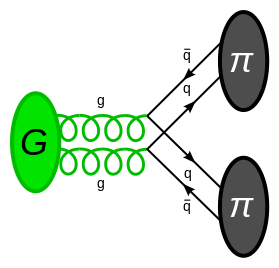Gluons are massless particles that transmit the strong nuclear force and bind quarks together. Gluons can theoretically form clumps called glueballs, which Wiki says would quickly decay. If glueballs are formed from massless particles then theoretically they travel at the speed of light, which should mean they experience zero time. But how then can they undergo decay?
Conservation of energy and momentum will restrict how a massless particle can interact/decay. Cf. the role of photons in electromagnetism; a photon just by itself will not turn into a pair of massive particles, but there are other paths for it to interact. As for gluons, they may be massless, but they interact with gluons, which is basically the idea behind glueballs (quantum chromodynamics). Glueballs themselves are not supposed to be massless, though. As for their decay mechanisms, people study mechanisms like this (diagram lifted from Wikipedia):

Note that such diagrams involve “virtual particles” so there are not any impossible vertices there.
One notion that you have to get out of your head is that mass is additive. It’s not. Any individual gluon, or photon for that matter, is massless. A group of two or more massless particles, however, almost certainly has mass.
The total energy of a system depends on what reference frame you’re in. Mass can be defined as that portion of the energy of a system that can’t be transformed away, no matter what reference frame you switch to. If you have a single massless particle just flying through space, in any given reference frame, it’ll have some energy, but you can always make that energy smaller by picking a reference frame that’s chasing after it at a higher speed.
But if you have multiple massless particles, and they’re not all going in exactly the same direction, then there comes a point where, by chasing after one of them to decrease its energy, you’re fleeing from another one, and thus increasing its energy. And so there’s some reference frame where the energy is as small as possible, but the energy still isn’t zero. That leftover energy is mass.
I love that you can tell a glueball “when come back, bring pie” and it never fails you.
That would be true if you were chasing after a classical particle whose energy (momentum) is a function of its mass and relative velocity. But isn’t it the other way around for a massless quantum particle like a photon? Its speed will always be a constant, c, but if you’re “chasing after” the photon (i.e.- moving away from the light source along with the photons) you’ll see a red shift, representing lower frequency, and since a photon’s energy is E = hf, you’ll see lower energy. But if you’re moving toward the light source (against the photon flow) you’ll see a blue shift = higher frequency = higher energy. Hence we see red-shift (lower energy) in galaxies that are fleeing from us.
Or am I missing something here?
Oh wait, I should have read the Wiki article more carefully:
Glueballs are predicted by quantum chromodynamics to be massive, despite the fact that gluons themselves have zero rest mass in the Standard Model.
Premise of original question refuted.
Perhaps a little too casual wording on my part: What matters isn’t actually whether you’re moving towards or away from the photon, but whether you’re moving in the same direction or opposite. If there’s a photon moving east and you’re moving west, it’ll be blueshifted. If you’re both moving in those directions from the same origin, then of course you’ll never directly detect that photon… but it’ll still be blueshifted in your reference frame, whether you detect it or not.